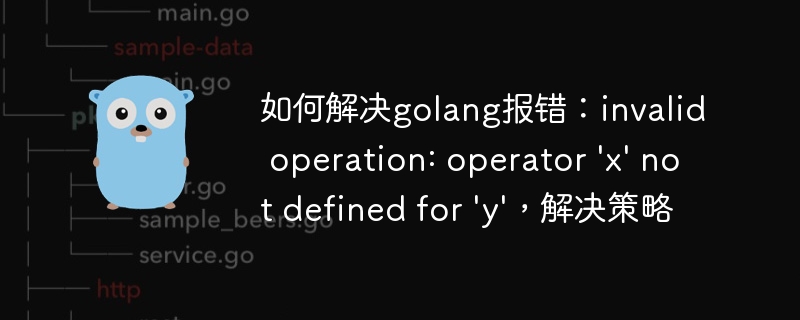

How to solve golang error: invalid operation: operator 'x' not defined for 'y'
In the process of using golang to write code, you often encounter some errors Information, one of the common errors is "invalid operation: operator 'x' not defined for 'y'". This error is usually caused by the operator not supporting the data type used. This article describes how to solve this problem and provides corresponding resolution strategies and code examples.
First, we need to understand some basic knowledge. In golang, each data type has its own operator. When we use an operator to process a certain data type, if the data type does not support the operator, the compiler will report an error, indicating that the operator is not supported. In some cases, we may mistakenly use an operator to handle an inappropriate data type, causing this error to occur.
In order to solve this problem, we can adopt the following strategies:
The following is a sample code snippet that demonstrates how to perform type conversion:
package main
import (
"fmt"
)
func main() {
var x int = 5
var y float64 = 7.5
// 将x转换为float64类型
result := float64(x) + y
fmt.Println(result)
}In the above code, we convert the variable x of integer type to float64 type, and then Add another variable y of type float64. In this way, we can avoid "invalid operation" errors.
The following is a sample code snippet that shows how to use type assertions:
package main
import (
"fmt"
)
func main() {
var x interface{} = "hello"
// 使用类型断言将操作数转换为字符串类型
str, ok := x.(string)
if ok {
fmt.Println("x is a string:", str)
} else {
fmt.Println("x is not a string")
}
}In the above code, we first define the variable x of the interface type as a string type . We then use a type assertion to convert x to string type and check if the assertion was successful. According to the result of the assertion, we can perform corresponding processing.
The following is a sample code snippet that demonstrates how to use type judgment:
package main
import (
"fmt"
)
func checkType(x interface{}) {
switch x.(type) {
case int:
fmt.Println("x is an integer")
case float64:
fmt.Println("x is a float")
case string:
fmt.Println("x is a string")
default:
fmt.Println("x is of unknown type")
}
}
func main() {
checkType(5)
checkType(3.14)
checkType("hello")
checkType(true)
}In the above code, we define a function checkType that accepts an interface type Parameter x, and use type judgment to determine the specific type of x. Depending on the type of x, we can perform different operations.
Summary: In golang, when we encounter the "invalid operation: operator 'x' not defined for 'y'" error, we should check whether the data types of the operator and the operand match. If there is a mismatch, we can use strategies such as type conversion, type assertion, or type judgment to solve the problem. By properly handling data type matching issues, we can avoid the occurrence of such errors and improve the quality and reliability of the code.
The above is the detailed content of How to solve golang error: invalid operation: operator 'x' not defined for 'y', solution strategy. For more information, please follow other related articles on the PHP Chinese website!




